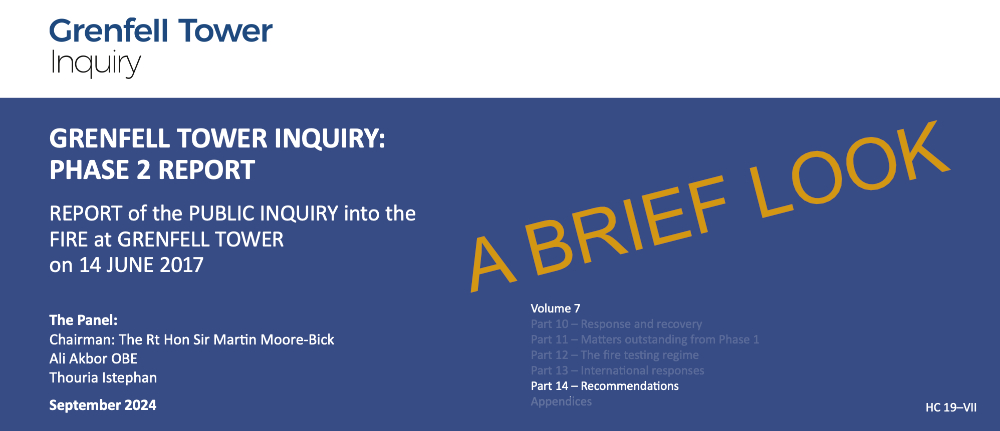Grenfell Phase 2 final report for construction at a glance
Contents |
[edit] Recommended measures in general
Terms of Reference of the inquiry included the recommendation of measures to be taken in response to deficiencies found to exist in the matters under investigation, these were grouped by reference to the subject matter under five headings:
- The construction industry - covered in this article
- Social housing providers
- The London Fire Brigade
- Response and recovery
- Vulnerable people
For a more detailed study of the issues relating to construction and the associated recommendations see the article the Grenfell phase 2 final report recommendations for the construction industry.
[edit] Issues at a glance
Here is a very brief look through some of the key issues discussed in the report:
[edit] Guidance and governance
- Deficiencies found in all four elements of; good design, the choice of suitable materials, sound methods of construction and skills, knowledge and experience of those engaged in the construction industry.
- Defining higher-risk buildings by height only and not considering the nature of use is problematic.
- Fragmented regulatory system mirrored in the numerous government bodies.
- Statutory guidance and documents unclear and mis-interpretable as to meeting the regulations.
[edit] Projects and products
- Issues regarding assumed stay put approach in the absence of rate of fire spread and escape time calculations.
- Fire spread is complex, small-scale and large-scale test methods lack relevant performance criteria.
- Failures to ensure a final versions of the outline fire safety strategies on completion of buildings.
- BS 9414 to be approached with caution, and not be a substitute for a qualified fire engineers assessment.
- Misleading manufacturers marketing material, of pseudo-technical natural without actual test data.
- Failures in the assessment bodies to uphold standards in testing and in monitoring certification.
[edit] Professionals and purpose
- Conflicts of interest of commercial product assessment combined with regulatory role in the public interest.
- No formal qualification or body, protecting the name or the practice of a fire engineer, so open to abuse.
- No authoritative statement of the skills of a fire engineer and thus little understanding by other professionals.
- Some evidence that architects have been failing to exercise proper care in relation to the choices of insulation.
- Contractor failings to clarify where responsibility lies between sub-contractors and a lack if interest in fire safety.
- Lack of awareness of client responsibility for compliance, improved by Building Act 2022
- Misinterpretation of building control as advisors rather than as enforcers of the Building Regulations.
- Conflicts of interest as of BC officers as guardians of the public interest arising from commercial interests.
- Competence issues of commercial fire risk assessors and the absence a regulatory scheme.
[edit] Processes and practicality
- No public record of reasons why previous recommendations not taken up by government.
- Significant issues in the compatibility of lift drop keys for fire control switches for the use of firefighters.
- Issues surrounding pipeline isolation valves lost over time and not checked regularly.
- Gas sleeving to pipework through walls and floors, missing, as never installed or checked in older properties.
[edit] Recommendations at a glance
Here is a very brief look through some of the key recommendations mentioned in the report (see the Grenfell phase 2 final report recommendations for the construction industry for further details):
[edit] Guidance and governance
- A single point of contact construction regulator responsible for pretty much all related fire safety issues.
- A review of the definition of higher-risk, beyond height to include the nature of use, incl' vulnerable people.
- Secretary of State appointed Chief Construction Adviser with budget and staff to advise on the industry.
- Statutory guidance with a warning, that they will not necessarily mean Building Regulations compliance.
- Review Approved Document B as a matter of urgency, and keep under continuous review, as with the others.
- Fresh approach in reviewing and revising the Building Regulations and statutory guidance with academia.
- A fire safety strategy by a registered fire engineer to be made a statutory requirement at Gateway 2.
- Add to guidance the value of calculating the likely rate of fire spread and the time required for evacuation.
[edit] Projects and products
- Steps to be taken to develop new test methods that provide reliable information needed for such assessments.
- Construction regulator responsible for assessing conformity of construction products and issuing certificates.
- Certificates of conformity should include copies of all test results and full testing history of the product
- Manufacturers required to provide on request copies of all test results that support fire performance claims.
[edit] Professionals and purpose
- Protect by statute the title and function of fire engineer and create a body of registered fire engineers.
- Pending a body, convene a group of practitioners and academics to produce an authoritative statement of the knowledge and skills to be expected of a competent fire engineer and offer appropriate courses.
- Higher-risk building control approval supported by statement from a senior manager of the principal designer.
- Higher-risk building control approval supported by statement from a senior manager of the principal contractor.
- Licensing scheme operated by the construction regulator for principal contractors of higher-risk buildings.
- Independent panel to consider conflicts of public interest and commercial interest for building control functions.
- Independent panel to consider if all building control functions, should be performed by a national authority.
[edit] Processes and practicality
- Construction regulator sponsored development of a construction library resource for designers.
- Government to legally maintain a public record of recommendations of select committees, coroners and public inquiries, steps taken in response to or reasons for not, scrutinised by Parliament, and reported annually.
- Introduce regulated commercial fire risk assessor scheme to ensure competence and confidence.
--editor
[edit] Related article on Designing Buildings
- Accountable Person
- BSI Built Environment Competence Standards
- Building a Safer Future - Independent Review of Building Regulations and Fire Safety (Hackitt Review)
- Building Regulations – Part B
- Building Safety Act 2022
- Building Safety Regulator
- Building safety in Northern Ireland
- Building safety in Scotland
- Building safety in Wales
- Building Safety Wiki
- Client responsibilities
- Competence
- Competence standards (PAS 8671, 8672, 8673)
- Competence Steering Group
- Fire safety
- Fire Safety (England) Regulations 2022
- Golden thread
- Grenfell Tower
- Grenfell Tower Inquiry
- Higher Risk Buildings
- New Homes Ombudsman
- Principal Accountable Person
- Principal Contractor
- Principal Designer
- Regulator of Construction Products
- Regulatory Reform (Fire Safety) Order 2005
- The Fire Safety Act 2021
Quick links
[edit] Legislation and standards
Fire Safety (England) Regulations 2022
Regulatory Reform (Fire Safety) Order 2005
Secondary legislation linked to the Building Safety Act
Building safety in Northern Ireland
[edit] Dutyholders and competencies
BSI Built Environment Competence Standards
Competence standards (PAS 8671, 8672, 8673)
Industry Competence Steering Group
[edit] Regulators
National Regulator of Construction Products
[edit] Fire safety
Independent Grenfell Tower Inquiry
[edit] Other pages
Building Safety Wiki is brought to you courtesy of:






